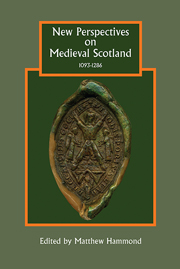Book contents
- Frontmatter
- Contents
- List of illustrations and tables
- List of contributors
- Acknowledgements
- Abbreviations
- Maps
- 1 Introduction: The paradox of medieval Scotland, 1093–1286
- 2 The Scottish ‘political community’ in the reign of Alexander II (1214–49)
- 3 Homo ligius and unfreedom in medieval Scotland
- 4 Scottish royal government in the thirteenth century from an English perspective
- 5 Neighbours, the neighbourhood, and the visnet in Scotland, 1125–1300
- 6 Cistercian identities in twelfth- and thirteenth-century Scotland: the case of Melrose Abbey
- 7 The language of objects: material culture in medieval Scotland
- 8 Structuring that which cannot be structured: a role for formal models in representing aspects of medieval Scotland
- Bibliography
- Index
- STUDIES IN CELTIC HISTORY
3 - Homo ligius and unfreedom in medieval Scotland
Published online by Cambridge University Press: 05 August 2013
- Frontmatter
- Contents
- List of illustrations and tables
- List of contributors
- Acknowledgements
- Abbreviations
- Maps
- 1 Introduction: The paradox of medieval Scotland, 1093–1286
- 2 The Scottish ‘political community’ in the reign of Alexander II (1214–49)
- 3 Homo ligius and unfreedom in medieval Scotland
- 4 Scottish royal government in the thirteenth century from an English perspective
- 5 Neighbours, the neighbourhood, and the visnet in Scotland, 1125–1300
- 6 Cistercian identities in twelfth- and thirteenth-century Scotland: the case of Melrose Abbey
- 7 The language of objects: material culture in medieval Scotland
- 8 Structuring that which cannot be structured: a role for formal models in representing aspects of medieval Scotland
- Bibliography
- Index
- STUDIES IN CELTIC HISTORY
Summary
In a conference on feudalism held in 1999, Chris Wickham identified three main ‘ideal types’ or models of feudalism that had dominated twentieth-century historiography: first, ‘Marxist feudalism’, which focused on the relationship between the peasant who worked the land, and the lord, who controlled it; second, ‘juridical feudalism’ or feudo-vassalic feudalism, which prioritised the relationship between lord and vassal, centred on the holding of a piece of land, the fee or fief; and third, feudalism as a type of society, comprising its economic bases, cultural manifestation and socio-political bonds. This type of society was outlined in the final few pages of Marc Bloch's Feudal Society and, in its ideal form, comprised:
A subject peasantry; widespread use of the service tenement (the fief) instead of a salary … the supremacy of a class of specialised warriors, ties of obedience and protection which bind man to man … fragmentation of authority … and, in the midst of all this, the survival of other forms of association, the family and state, of which the latter was, during the second feudal age, to acquire renewed strength.
Wickham's ‘ideal types’ of feudalism are not uncontroversial interpretive frameworks. But in this case they provide useful entry points through which to analyse the historiography of twelfth- and thirteenth-century Scotland, the period when the kingdom is traditionally thought to have become ‘feudalised’. Within Scottish historiography, debates on feudalism remain almost exclusively within the framework of the ‘feudo-vassalic’ or ‘juridical’ model, for two reasons.
- Type
- Chapter
- Information
- New Perspectives on Medieval Scotland, 1093-1286 , pp. 85 - 116Publisher: Boydell & BrewerPrint publication year: 2013

